Media | Articles
Your handy 1949–79 Volkswagen Beetle buyer’s guide
The Volkswagen Beetle is more than a car. It is a fixture in the landscape of our lives. If not only because so many of them were made—some 21.5 million over 65 years—the humble Bug rolled through history like a little air-cooled Forrest Gump. It was, at various times, a propaganda tool for facism, the poster child for revolutionary advertising campaign, a groovy symbol of the Summer of Love, a champion of the hot-rodding community, and a movie star. To say nothing of inspiring the likes of the Meyers Manx Dune Buggy.
Likewise, the Beetle enthusiast community casts a wide net, from vintage purists to Cali-look gearheads. You can have any kind of VW Beetle experience you want, but it’s useful to have some kind of plan in advance. Here’s a look at the heritage of the Volkswagen Type 1, which we hope will help you figure out what kind of Bug fits you best.
(As Brendan found out during his recent time behind the wheel, Beetles aren’t especially unique but every drive is special. —EW)
An unlikely phoenix
Any discussion of Volkswagen must confront the car’s regrettable origin story. As an example, the very first owner of a civilian convertible VW was Adolf Hitler. History is full of uncomfortable truths.
Conceived as part of the Third Reich’s nationalistic Kraft durch Freude leisure propaganda, the original Volkswagen was intended to be a people’s car for a uniform, pleasant, and obedient German populace. Kraft durch Freude means “Strength through joy,” and it included government-approved holidays, entertainment, and tourism. The KdF-wagen, as Hitler called the VW, was intended to bring motoring to the masses.
Marketplace
Buy and sell classics with confidence
Except that wasn’t really the point. German workers received a special booklet to be filled with stamps as they saved up to prepay for the car. Hundreds of thousands of people joined the program, which ran right through until the end of WWII. None of them actually got a Beetle, as the factory, of course, changed over to building war supplies like the military-issue Kubelwagen, and that’s where the money went. It was a bait-and-switch.
However, a few civilian-spec Volkswagens were completed by 1939. Development work was done by Ferdinand Porsche, who was charged by Hitler to come up with a car that could comfortably fit two adults and three children, cruise at 100 km/h (62 mph) on the newly-built Autobahns, and consume no more than seven liters of fuel for every 100 km driven (about 32 mpg). The cost was capped at 990 RM, or about the price of an average motorcycle.
The Kdf-wagen was just over 160 inches long, with a 985-cc flat-four air-cooled engine mounted in the rear. It was rear-wheel-drive and the transmission was a three-speed manual. Brakes were drums front and rear. It rode on a torsion beam suspension.
Here’s where the waters get muddied. While Porsche did develop several prototypes before coming up with two Type-60 pre-production Volkswagens in 1935, the Beetle’s creation has other fingerprints on it. A Jewish engineer named Josef Ganz developed a very similar rear-engined people’s car called the Standard Superior, and he showed it off at the 1933 Berlin Auto Show, which Hitler attended. In 1934, the Gestapo arrested Ganz on trumped-up charges. He eventually was forced to flee and escaped to Switzerland.

There are also clear similarities between Porsche’s ideas for the Volkswagen and some Tatra prototypes dating back to 1933. Tatra sued, but Germany’s invasion of Czechoslovakia put an end to any legal claims. After WWII, an Austro-Hungarian engineer named Béla Barényi successfully sued for credit as his technical drawings made in 1925 are very close to the Beetle’s basic design.
And before we can get to the first Volkswagens to actually make it into the hands of civilian drivers, there is yet another Father of the Beetle to acknowlege: Major Ivan Hirst. After Germany’s defeat, American forces had turned the control of the Volkswagen factory in Wolfsburg over to the British Army. Intial plans were to strip the factory and turn its manufacturing equipment over to an English car company—but no-one wanted it. An official report predicted the Volkswagen would be a complete commerical disaster.
Hirst disagreed. After disposing of a large, unexploded Allied bomb that would have taken out the production equipment—another bullet dodged by the Beetle—he ordered the factory begin production. These first cars were used in for military duties by occupying forces, but civilian production began shortly afterwards. By the late 1940s, Germany’s people’s car was made available to the people.
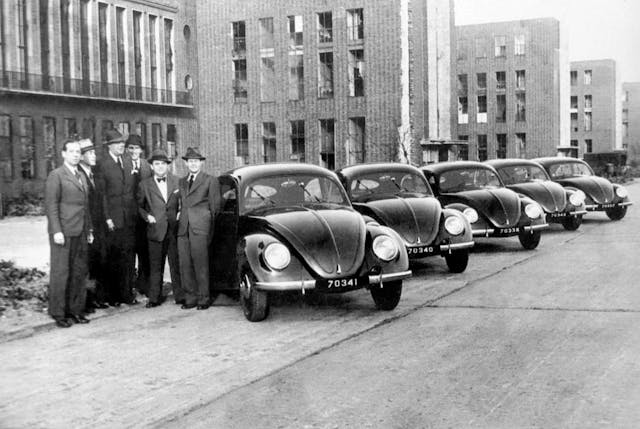
Charting the changes
Early Volkswagens are the most valuable, despite being the least suited for modern traffic. In their day, the original 25-hp, 1131-cc engine was up to the task of autobahn driving; but in a modern world of fast-moving interstate traffic, threading a Bug through the lines of F-150s is for the very brave.
Early Beetles are also the most delicate, pure, and pretty. It should be noted here that the “Beetle” and “Bug” appellations are just nicknames, and these cars were simply called Volkswagens. To a European market starved for transportation, the economical cars were an immediate success. When Volkswagen arrived in the U.S. in 1949, it sold just two. Ben Pon, a Dutch racing driver who had success selling the Beetle in the Netherlands, tried in vain to sell what he called the “Victory Wagon,” to a postwar American audience. They weren’t buying.
The next year, New Yorker Max Hoffman wrangled a deal as the sole U.S. importer of Volkswagens, and his gamble paid off. He sold 160 cars in 1950, then 320 in 1951. The Beetle had arrived.

The first 1950 cars came with a split rear-window that is immediately recognizeable among VW fans. Original price for a standard car was $1280 (just under $16K today), although most buyers coughed up the extra $200 for the chrome and creature comforts of the Deluxe model. A standard split window is like a time warp back to the prewar design of those very first pre-production Volkswagens, more a car of 1930s futurism than a vehicle to fit the postwar boom. The interiors have plenty of exposed metal, there’s a single exhaust pipe, and the turn signals are semaphores. This simplicity just adds to the elegance.
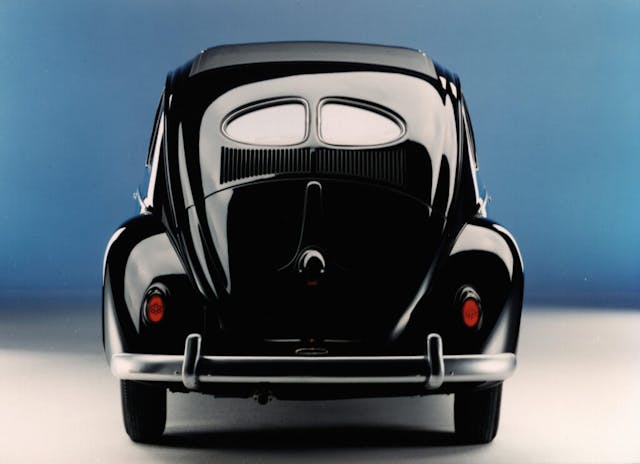
Hoffman soon turned to selling Porsches, but based on his initial success, Volkwagen itself entered the U.S. market in 1953. That year also saw the changeover of the split rear window to an oval. In 1951, the VW had been upgraded from cable-operated brakes to hydraulics, and received a slight bump to 30 hp. With synchromesh fitted to all but the first gear of the four-speed manual, the Beetle was now much easier to drive.
Through the 1950s, small changes came year by year, and these are the details that Beetle enthusiasts delight in obsessing over. Bigger improvements include a bump in displacement to 1200 cc in 1954, for some added torque and peak power of 36 hp. By 1956, the Beetle had lost its 1930s-style semaphore lights for conventional indicators, and had gained the characteristic chrome “pea shooter” twin-tailpipes.
By the mid-1950s, when Volkswagen of America was formed, one million Beetles had been built. United States sales were still small, roughly around the 9000 mark in 1954, though they would shoot up significantly the following year. As the 1960s beckoned, this little car was really going to come into its own.
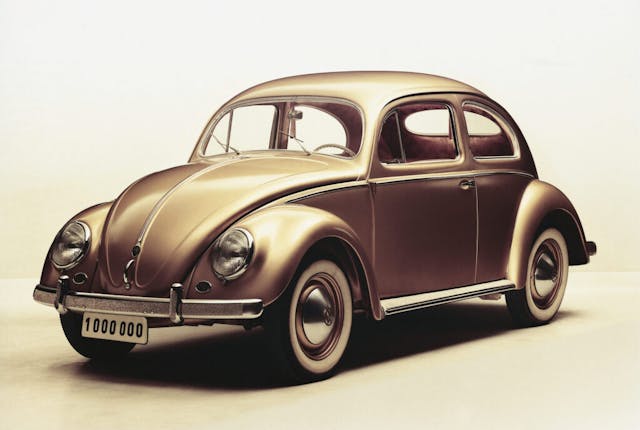
“Think Small”
Probably the most famous automotive advertising campaign—the simple, quirky ads thought up by the Doyle Dane Bernbach corporation—are Mad Men come to life. One ad, with the tag line “Think Small,” shows a black-and-white image of a tiny Volkswagen positioned in the corner of a blank white space. Launched in 1959, it heralded a wave of clever commercials that had people beating down the doors of their local VW showrooms.
Beetle sales exploded in the late 1950s into the 1960s. 1960 saw U.S. sales figures crossing the 100,000 unit mark, and by mid-decade Beetle sales were triple that. Watch any movie or sort through old family photos of the time, and there’s often a Beetle lurking in the background. No wonder the classic roadtrip game of “Punch Buggy” became so popular, despite being so painful for younger siblings.
If a 1950s Beetle is celebrating the engineering and design of the original, the 1960s version allows for a little more creativity. Here’s where the VW fell into the hands of many car customizers, and began its transformation into a mainstay of SoCal car culture, even if you could find that California style on both coasts or anywhere in the middle.
There’s something intensely satisfying in Hitler’s original vehicle for a uniform and docile population ending up as the ultimate counter-culture car. The first Bug In, a popular VW meetup, was held in October 1968, and saw VeeDubbers partying, swapping parts, running door-to-door down the dragstrip, and generally having having a great ol’ time.

The Beetle saw a bump to 1285 cc in 1966, and it now wore a “1300” badge on the rear. All windows had been enlarged in the previous year, with a new, slightly curved front windshield, giving Beetles of this era a more airy feel, though they are not actually any larger. In 1967, the Bug saw another bump in displacement to 1493 cc, and this 53-hp “1500” became the standard offering in North American Beetles.
Even more significant changes came in 1968, with a comprehensive change to the Beetle’s overall look. Some of these improvements were convenience items, like a spring-loaded fuel flap (previously, you had to open the hood to fill up). In a stroke of thrifty genius, the windscreen washer was pressurized by being connected to the spare tire; there was a check valve to prevent the spare tire from losing pressure below 30 psi. The Beetle also got safer, with new bumpers, a collapsing steering column, and a secondary hood latch. There was also a three-speed, semi-automatic transmission on offer, making Beetle ownership possible for those who didn’t want to learn to drive stick. These semi-auto cars got an improved trailing arm rear suspension (Beetle fans refer to this as simply the Independent Rear Suspension) that could also be specially ordered on manual cars and which found its way into all North American spec Beetles the following year.
Also in 1968, Herbie showed up in the film The Love Bug. Autonomous driving is a hotly debated topic these days, but Disney’s self-aware 1963 Beetle brought the charms of a VW to a younger audience. The cultural impact helped prolong the car’s appeal into a new decade.
Super Beetle!
By the time the 1970s rolled around, the Beetle was no longer one of the only players in the compact segment. In the early going it was still competitive in the sales charts, but the likes of the Honda Civic and a host of small Datsuns were arriving, ready to topple Volkswagen with a new type of imported people’s car. So, to fight back, VW went about addressing the complaints owners had about the Bug.
In 1971, VW launched the Super Beetle: everything you loved about the Beetle, but more of it. Two inches longer than the standard VW Type 1, the Super Beetle had 60 hp from its 1600-cc engine, larger brakes, and a new MacPherson strut front suspension added to trunk space. The standard Beetle was briefly sold alongside the Super Beetle. The Super Beetle is a milestone model for the brand, with 1972 marking the year the Beetle hit over 15M built, surpassing the Ford Model T.

You can think of the Super Beetle as analagous to the 996-chassis Porsche or the third-generation NC Mazda MX-5. It’s the least-cool member of the family, but it’s still from a solid bloodline and can be a fun and interesting classic to own and modify. Perhaps the pick of the litter here is the convertible version. Because VW had released the water-cooled Rabbit/Golf in the mid-1970s, anyone still shopping for a Beetle was doing so mostly out of whimsy, and convertible sales remained strong as demand for the sedan tailed off.
Further, by this time, the Beetle’s familiarity had bred some contempt. Why would you restore a car which existed in the millions? Many Super Beetles ended up in scrapyards because they were just an ordinary car. Convertibles were a bit more special, so more seem to have been preserved.
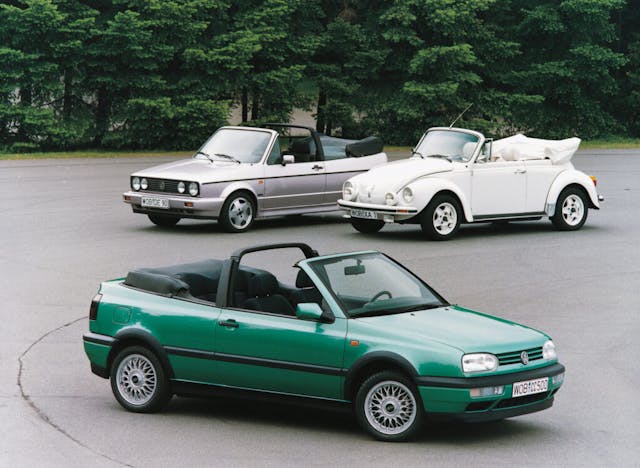
A Mexican epilogue
The last German-made Beetle left the line on January 19, 1978, though Beetle convertible sales continued in the U.S. until an extended 1979 model year. However, south of the border, Mexico wasn’t about to let the Beetle go extinct. The Volkswagen de México factory established in Puebla produced its first VW Beetle in 1967, and would go on to continue to build them until, somewhat incredibly, 2003. For a brief time, it was even possible to buy a Mexican-built Beetle in Germany, where there was residual affection for the little car.
Mexicans called the VW Type 1 the Vocho, and it became a part of everyday life as it had been in the U.S. during the 1960s. Making up an estimated 20 percent of road traffic around the country, the Vocho was also the most common taxi in Mexico city, bright green and white little Bugs scurrying all over.
Through the 1980s and ’90s, Puebla-built Vochos were available in a series of special editions, mostly comprised of unique colors and interior fabrics. When the final Vocho rolled off the line on July 30, 2003, it was serenaded by a mariachi band, having become as much a part of Mexican culture as it was German.

Before you buy: Death foam and other worries
Before we get to a specific Achilles’ heel of later Beetles, there are a few straightforward checks that should be done on any Bug. Corrosion can often be found behind the front wheels and at the bottom of the heater channels; warm air from the engine is ducted to the cabin from these channels, and as warm air also carries more moisture, they can be a common Beetle rust area. Both the front and rear windshield can trap water, so a careful check of the rear luggage tray is in order.
Another quick trick to check for bodywork issues is to check to see if the doors droop when you open them. Hinge pins do wear out, so a drooping door isn’t definitive proof of rot, but it can signal an issue with the lower hinge.
Most alarming is the spray-in expansion foam that VW used in Beetle C-pillars from 1971 forward. This stuff was an absolute haven for moisture, so if you see surface rust bubbles in this location on this era of Beetles, be forewarned that the car is rotting from the inside out. VW enthusiasts have taken to calling it “death foam,” and for good reason.
From a mechanical standpoint, the Beetle’s series of air-cooled engines were simple and durable. Some brief oil burning on startup isn’t out of the ordinary for a flat-four engine, but persistent smoke indicates a bad seal. Likewise a little oil seepage around the pushrod tubes is normal, but it shouldn’t be excessive. Fuel injection arrived in 1975, but this system something of a double-edged sword. When working well, it’s great. But the system is relatively not well understood by the broader VW community, so finding an expert to help an owner troubleshoot any problems is not easy. Often, owners of these later cars will simply replace the system with traditional carburetors.
Body condition is probably the most important consideration, but there are of course replacement parts for pretty much everything. The Beetle is nearly as ubiquitous as a classic as it was when new, and it is supported by a huge aftermarket. Finding and buying a previously completed restoration provides a generally hassle-free pathway to ownership, but if you’re the type that likes to turn you own wrenches, parts supply is good. These cars are relatively simple to work on, and there is a wealth of information out there on them.
One word of caution, however. Because it’s so popular, Beetle parts can be of varying quality depending on manufacturer and country of origin. Some of the more budget-friendly replacement bits aren’t the best, and a buyer should be cautious when looking at a restored example, making sure to check to see that the best was used.
Basically, if you’re interested in a purist expression of the original Volkswagen, then you want a split-window Beetle. And if you can’t get your hands on one of those, you probably want an oval. Parts for the early 25-hp cars are available but they are quite expensive, which might not be a big deal if you don’t plan on keeping it forever; early Beetles fetch top dollar at auction, so painstakingly accurate restorations do pay off. While the ’50s Beetle is the purist’s choice, 1960s Volkswagen enthusiasts go crazy for period-correct aftermarket parts. Scouring swap meets to find rare aftermarket accessories turns ownership into part treasure hunt, and is all part of the fun. As one example, a vintage, German-made Bekowa wood-slat makes a perfect crowning piece for your California-look Beetle project.
A 1968 or ’69 VW is less desirable than a mid-’60s version, simply because the looks changed so much. Having said that, a late-’60s Beetle is possibly the sweet spot in the range for finding a bargain. The cars drive very well, and they still offer that compact Beetle feel. They’re also ideal as a platform on which to build a modified car, with a built-up engine, improved braking (usually front discs), and reworked suspension. A manual 1968 or ’69 with the trailing arm suspension makes for a great buy. Super Beetles are not as beloved as the VWs of the 1950s and ’60s, but they are one of the most affordable and practical ways to get into Beetle ownership.

Volkswagen owners are usually very club-oriented, so it’s fairly easy to seek out your local chapter and find guidance. Other useful sites are The Samba, which has a focus on more stock and period-correct VWs, or the Shop Talk forums, which skews more towards modified VW enthusiasm.
Valuation
For the most up-to-date values on any year of Volkswagen Beetle, be sure to check Hagerty’s Valuation Guide here. As might be expected, the earliest cars are the thinnest on the ground and fetch the highest prices. The trend seems to be expanding.
Almost all Beetles experienced a price spike at the end of the 2010s, benefitting from the surge in air-cooled 911s. A Beetle is not a Porsche, but it does have some Venn diagram overlap with enthusiasts, and it’s not uncommon to see a Porsche collector tuck an early VW in their collection.
Overall, median #2 prices are up 250 percent in the last decade, but there are some high points. The real spike is seen in early split window cars, which are up some 300 percent in the past 10 years. These and the oval window cars are the blue chip Beetles.
Prices for the later 1950s and early-to-mid-60s cars are rising steadily, but with less of a spike. In the last three years, values have risen by 47 percent. For Beetles from 1968 to 1979, prices have shot up most sharply for the sedans, though convertibles are still overall more expensive. Condition #2 values over the last five years are up 126 percent for convertibles and 155 percent for sedans. The bulk of the interest in Beetles comes from Boomers and Gen X, which make up about 70 percent of the quotes.
By make and model, the Volkswagen Beetle is the 11th-most insured car with Hagerty. More tellingly, it is also easily the most popular non-American classic car in the U.S. With so many out there, and such a big fanbase, it’s the perfect classic car to find a match for your personality.
Check out the Hagerty Media homepage so you don’t miss a single story, or better yet, bookmark it.

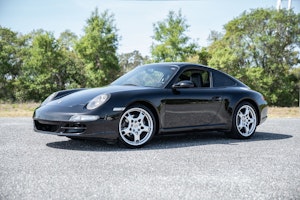


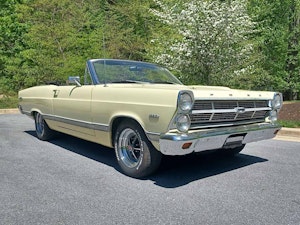
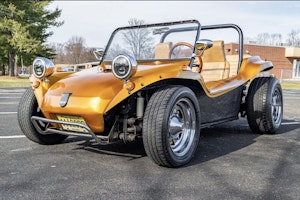

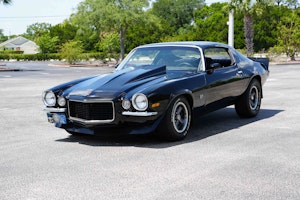
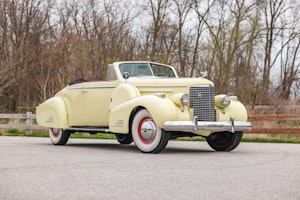
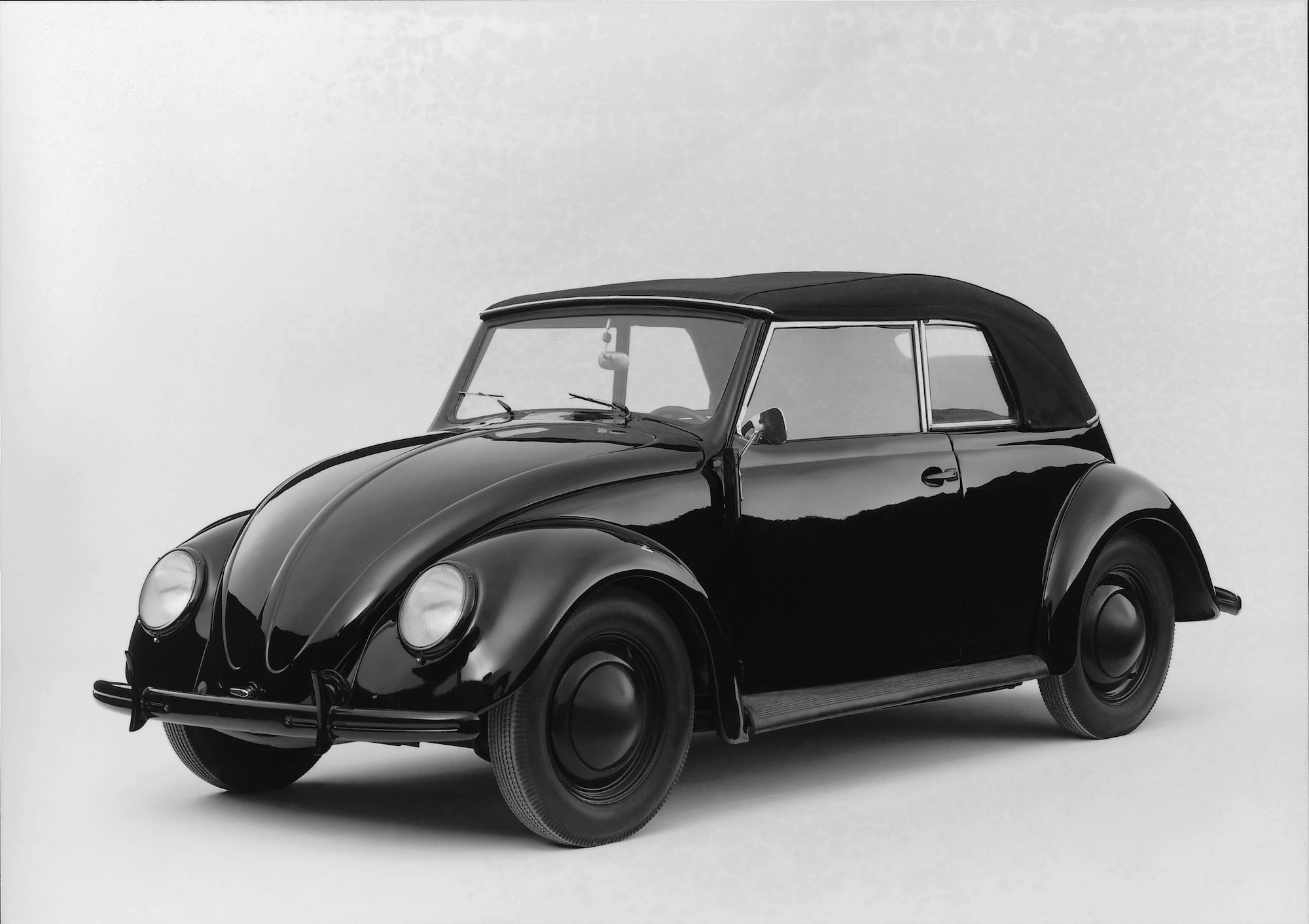
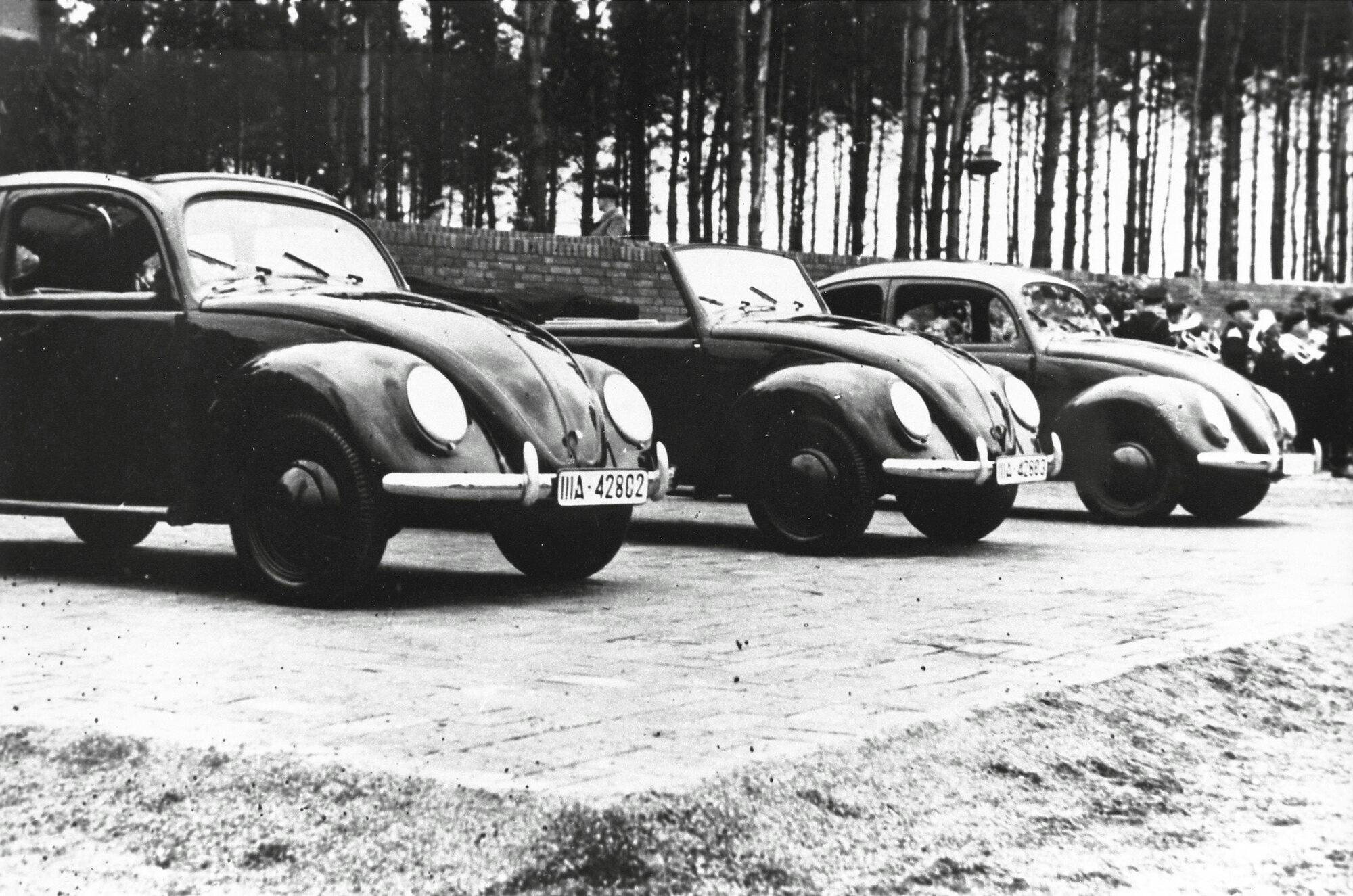
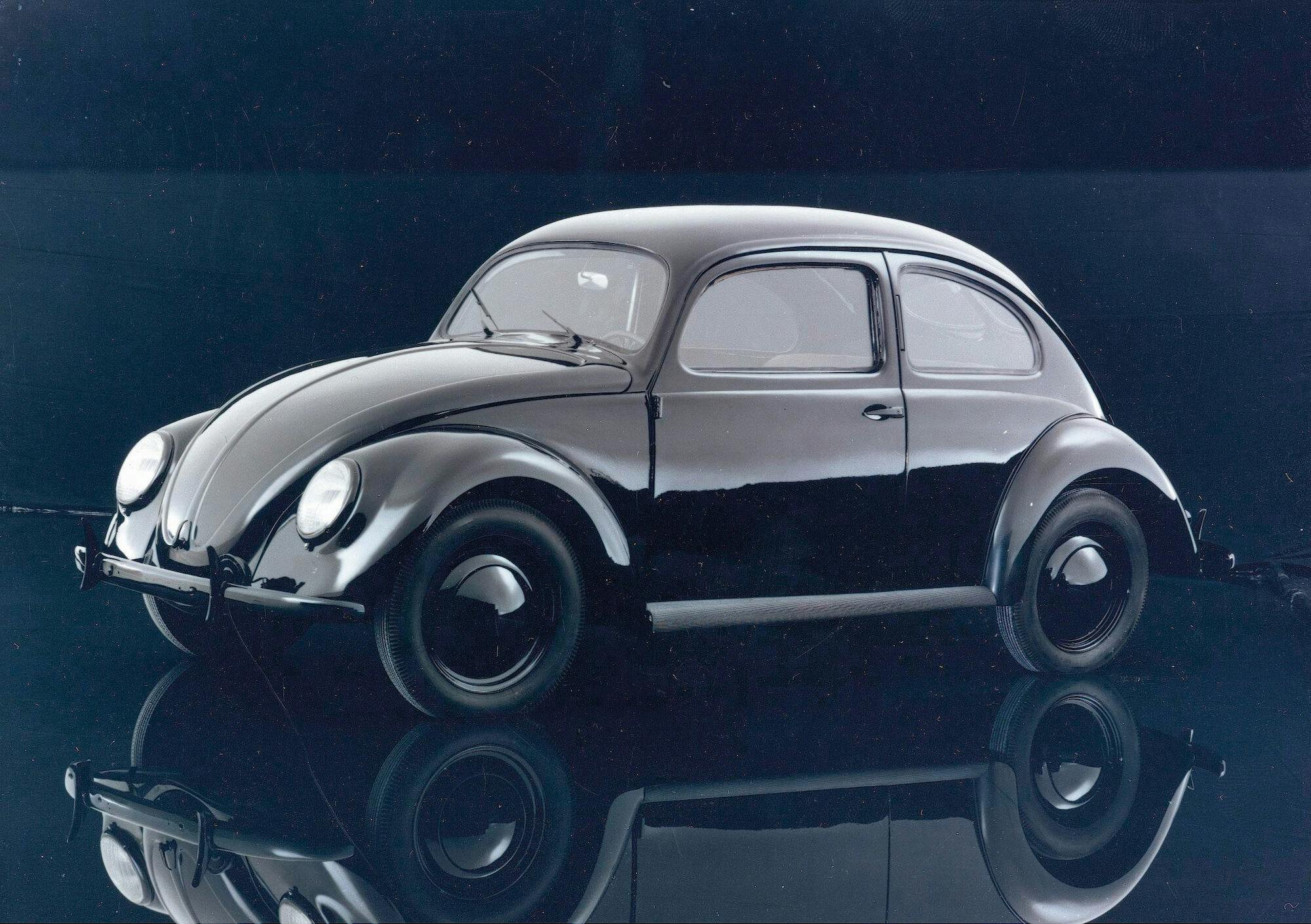


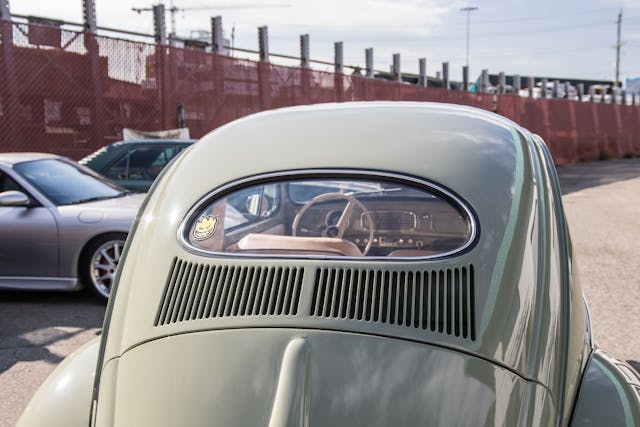
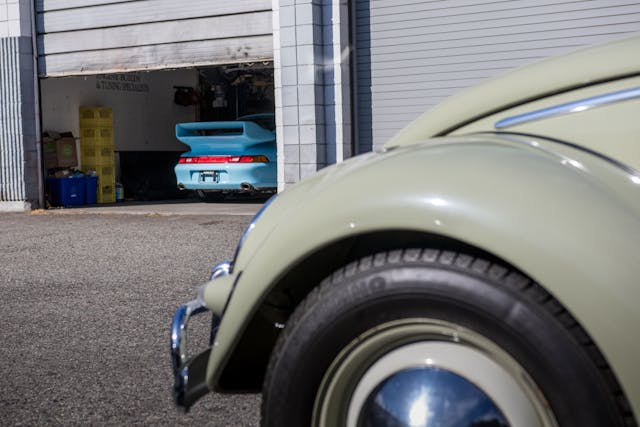















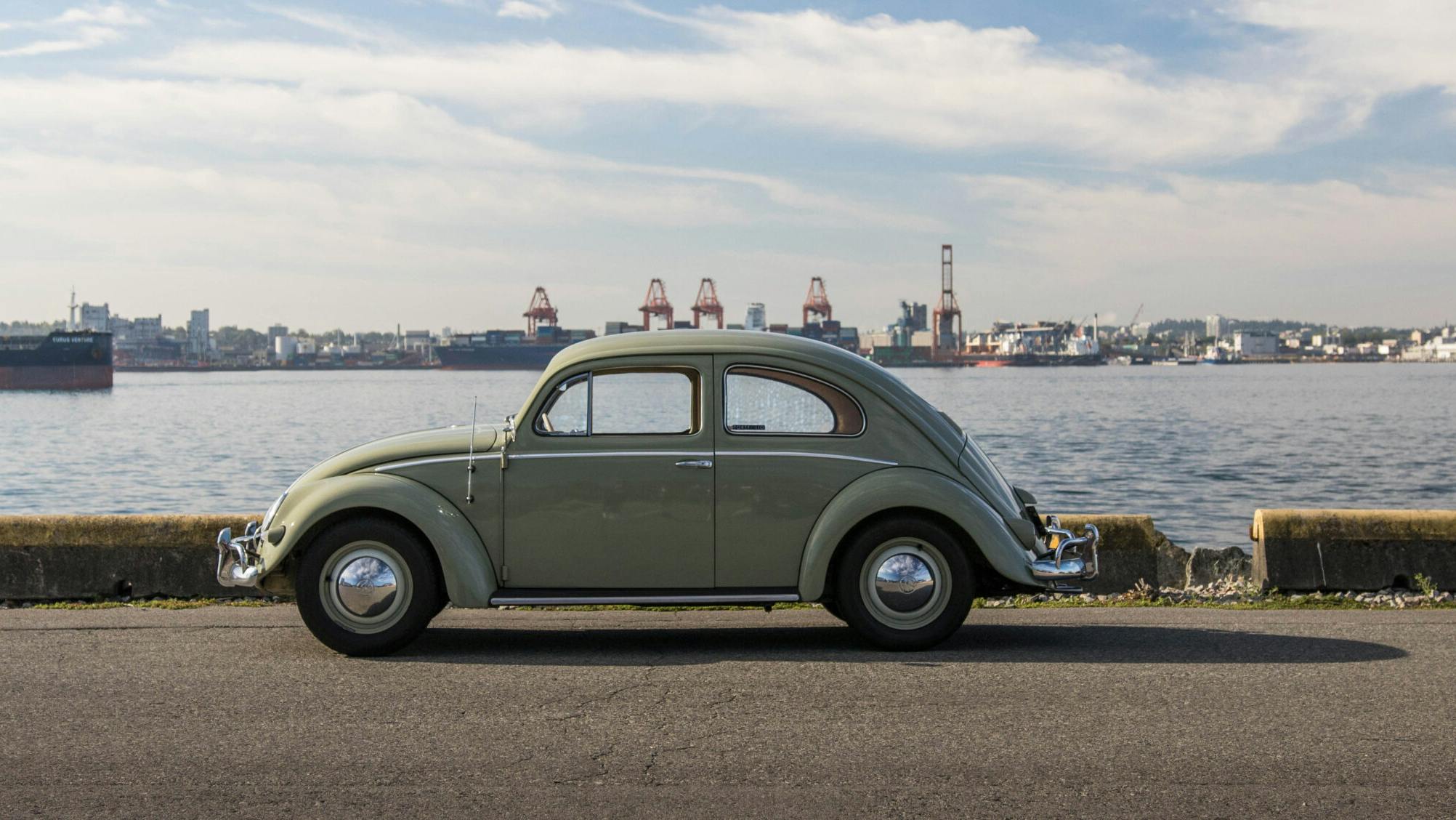
Had a 66 with the 1300 on it. 3 brothers. Over 200.000. No heat – always rusted out. Running boards. – rusted. Had to bend the engine hood to get around the rear bumper – was always getting tapped. But was only $1999 and best ever in Ohio snow. Still miss it.
Owned 2 VWs A ’49 split with what I was told was an “earlier” engine – in Zambia – and an early Rabbit (first year of FI ) and also drove an injected 412 wagon and a shortened ’62 beetle with the roof cut off (also in Zambia) The “wabbit” as the only one I had here in north America (Canada). The ’49 was about as basic trasportation as you could get – made my ’28 Chevy seem modern in comparison!!!!
My first car was a 67 beetle and my second car was a 72 Karmann Ghia that I bought in 1975. How I wish I had both of those vehicles back now.
Still have my ‘67 Beetle, my first car that I bought in Arizona in 1984 for $1200. It’s now my resto project. It’s an early ‘67 (117 050 xxx), which has the old style front seat recliners, ‘66 and older style rear bumper, round side mirror, and the ‘66 oil bath. The 1967 model year was truly a transition point for the Beetle.
I sold VW’s at a dealership in Owings Mills, MD from 1969 to 1972. I could have sold hundreds, but we could not get enough of them to keep up with demand. Most were sold as pre-orders, taking 4 to 6 weeks for delivery. I sold probably as many used ones as new ones. The best year by far IMO was the 1967, fewest problems and just enough improvements. My favorite to drive was the Karmann Ghia. The one I made the most commission on was the Type 2 or VW Bus / Camper. The hardest thing to overcome with buyers was the fact that there was no discounting. Every one was sold at sticker price, plus dealer prep and undercoating. That’s how popular they were!
Through the late 50’s 60’s and into the 70’s I had 4 different Beetles (Last being a Yellow 1970 Bug Convert) Loved it. Great Ontario Canadian Winter cars other than the interior heaters (the 1970 convert had a gas heater.) Traded it in for a 1975 Cougar XR7. Two years ago found a 74 VW Yellow bug convert. Loved it and had to have it. It needed a new floor which was not a big deal and inexpensive. Now back to fun motoring with the top down in the Summer. This is my 5th Bug.
I was a Porsche lover and hot rod builder, and got drafted in 1965, and went to Nuremberg West Germany, as a dental tech, in 1966. as soon as I made E4, and made $168 a month, I bought a 1963 Bud with the big fabric sunroof, for six hundred dollars. I bought it on my 22nd birthday, and was the best present I ever got! Gas was 16 cents a gallon, through the Army. The engine threw a rod, in early 1967, and I bought a rebuilt one
from a German VW Dealer, Installed, two year guarantee, for 80 dollars! shipped to my home in California, for 600 Busks, and it arrived on my 23rd birthday. Perfect car for Germany, but sold it when I got home , and Bought a 68 Camaro, 327 four speed, Great car, and would like to have it back today. bought a new Porsche 911T, in 1971!
Hmmm. thinking about a resto-mod: the early, purest styling atop a later pan, with a 2180, disc brakes, upgraded electrical, suspension, tires & wider wheels…
MY FIRST AND SECOND CAR WERE VW BUGS, A 1962 AND A 1968. I BOUGHT THE ’62 IN MY JR. YEAR OF HIGH SCHOOL FOR $200 BUCKS IN AUGUST OF ’71, WHO CARED ABOUT HEAT IN AUGUST? WELL I SHOULD HAVE BEEN, BUT DIDN’T GET CONCERNED UNTIL NOVEMBER IN MICHIGAN COLD WEATHER STARTED REARING IT’S COLD FACE. THE FLAPS WERE ALREADY WIRED SHUT, THAT SHOULD HAVE BEEN MY FIRST CLUE. HOWEVER I LEARNED TO DRIVE WITH 3 HANDS. ONE ON THE WHEEL, ONE ON THE SHIFTER, THE OTHER ON A SCRAPER CLEANING THE WINDOWSHIELD. I HAD SEVERAL SCRAPERS ON THE FRONT SEAT SO IF I HAD A PASSENGER THEY HAD A CHOICE OF WHAT SCRAPER THEY WANTED TO USE TO GET THE ICE OFF THE WINDOWS. IN MY LAST YEAR OF HIGH SCHOOL I GOT A BETTER JOB SO I BOUGHT A NEWER V-DUB. A 1968 WITH A GAS HEATER!!! THAT WAS A NICE CAR, NO RUST, STARTED EVERY COLD WINTER MORNING, AND WAS , AT TIMES TOO WARM. (IMAGINE THAT). THE BUGS WERE TOO SLOW, SO AFTER A COUPLE OF MG’S IT WAS ON TO CHEVY’S AND NO LOOKING BACK. THE OLDER VW’S HAD A SOUND OF THEIR OWN YOU JUST CAN’T FORGET, SOMETHING THE NEW BUG NEVER HAD.
Fun cars. The crazy hot-rod engine swapped ones are hilarious.
Loved building and driving the vwub. Had a 60’s van that traveled from colorado to florida. Blew a transaxle in kansas. Old timer towed us to his shop, told us where to dig out a trans from junk pile in back of his shop, lent us tools and put us up at his hotel. 2 days later we were back on the road headed to Gainesville. Felt sorry for 2 19 yr olds without much dough! Drove a number of bugs and had a great time in Denver area. Back then u could buy a jug and piston rebuild kit. Put inserts in block new studs and build some decent power. Also drove gias and things. Those were the fun days!!
With a good floor jack, I could remove and replace the engine by myself. Had four VW’s. Great cars.
A beautiful little car in its own right. We have a 1967, Java Green bug and it is a fun car to drive to shows and to church. SO simple yet SO rewarding.
I’ve owned a ‘74 Standard Beetle, ‘65 Bus, ‘88 Golf, ‘82 Westfalia camper, ‘57 Beetle in that order.
My current Volkswagen is a 1965 Sea Blue sunroof Beetle that I found in a barn located just outside of Fargo ND after the original owner gave it to her grand son in law to store in his barn. It rested there for over 30 years, driven periodically and fluids changed. At 82k original miles it had its share of minor dents, dings, scratches and original drivetrain that still ran. The interior is all original and in very nice condition, including its original headliner and Terra Gray cloth seat covers that at some point were covered with vintage seat covers. I rented a truck and trailer and drove it home over a few mountain passes through snow storms and past one jack knived semi truck and trailer laying on its side. Once home I did some work myself, brakes, pounding out minor dents, painted scratches and spent a few hours with a buffer and 3M rubbing compound to bring the mostly original exterior paint back. I swapped the back bumper from the ‘67 I owned at the time because it was an aftermarket one with a kink in the middle. I had the engine and transmission rebuilt locally and here’s where things get tricky…trying to bring a Beetle back 57 years later to make it safe and roadworthy. Three of my previous mechanics were dead by now and no longer in business. The guy in the next town over couldn’t be trusted so I recovered the car from his shop (engine completely tore down at this point) with a tow truck and a couple local sheriffs. I found another shop nearby, but his knowledge of VWs was somewhat limited. He wanted to make most of his money in rusted VW metal repair work and had taken on too many projects. His uncle rebuilt my original 40hp motor with rod knock because he didn’t check the clearances, so the motor had to be removed and tore down a second time. The same happened with the transaxle rebuild sourced out to a different mechanic. After being rebuilt it leaked and the recommended taller 4th gear was making bad noise. In the end, the shop installed my clutch wrong (Boden tube didn’t have enough bend). When he rebuilt the steering box he didn’t center it so the right side tire rubs. When he rebuilt the king and link pins he reamed too much metal so they’re too loose.
I tell you all this because pulling a Beetle out of storage in 2021 is different than it was 30 years ago. Mechanics have passed away, VW shop tools have been scattered, knowledge has faded and as this article has stated, many of the parts come countries other than Germany. My pistons and cylinders came from China.
But once everything on your list is done and you pull into a parking lot with your 1965 Beetle all that goes away. You’re accompanied by an iconic celebrity that most people young and old can relate to and have a personal story about. Not once has anyone asked me about those little dings or scratches and I don’t have to worry about scratching new paint because it’s a survivor that bears its 57 year story well. New paint would simply erase that story
I had a 1967, loved it, and all the experience owners had driving them in San Francisco with the hills and all.
You could put it practically anyplace in those days, and with the nightmare parking the car was a gift for that
and many other reasons. I have no room for it now, and the prices are astonishing for a nice car if one remembers what one paid from the showroom ($1875.00) is pretty close I think, with an AM-FM Radio no less, Antenna, and the pinnacle of luxury, a gas gauge.
The author might want to recheck their research on the use of semiphores in the U.S. U.S. spec cars always had hydraulic brakes and flashing turn signals.
My first car was a 1969 Beetle, bought in 1973. I refused to buy a 1968 because of the swing-arm rear suspension (on stick-shift cars, which I wanted), and I did not like the old-fashioned bumpers (or again, the swing-axles) of the pre-1968 Beetles. It was a fun car.
I have never understood the lack of love for Super Beetles. I had a 1972, and the extra truck space was useful. It probably handled better, too, but I could not quantify that.
My last Beetle was a 1979 convertible bought new in 1980, in the beautiful “River Blue Metallic” – happily, with gasoline heater!